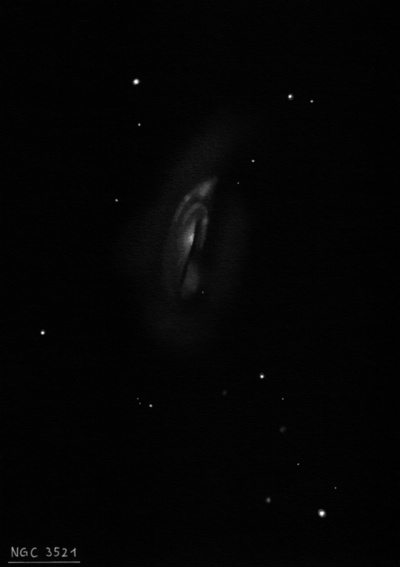
William Herschel discovered NGC 3521 = H I-13 = h818 on 22 Feb 1784 (sweep 153) and recorded "a fine B nebula, with a bright star or nucleus in the middle; it sends out a milky ray towards the north, and another more F towards the south, the extent of the whole, faint rays included, may be about 7 or 8'. On 13 Aprl 1828 (sweep144) John Herschel described NGC 3521 as "vB; L; mE in PA 140° +/-, 4' l, 1' br; vsvmbM; a double star follows. The NGC position (measured by Auwers, d'Arrest, Peters) is accurate.
R.J. Mitchell, observing at Birr Castle on 29 Mar 1856, recorded "The nucleus projects into the dark space along the p edge. Outside this dark space there is faint nebulosity, which I see joining the nebula at the north end."
200/250mm - 8" fairly bright, fairly large, elongated, bright core. Located 33' E of a mag 6 star.
400/500mm - 17.5" (1/19/91): very bright, very large, elongated 5'x2' NNW-SSE. This is an impressive galaxy! Contains a well-defined small bright oval core NNW-SSE and a stellar nucleus. Appears mottled near the core and on the west side. Along the west side is a dust lane evident as a sharp light cut-off. The west side is somewhat fainter due to dust but extends beyond the dust lane.
900/1200mm - 48" (3/1/19): at 488x; showpiece spiral with a prominent dust lane and an outer spiral arm! The galaxy appeared extremely bright, very large, elongated ~5:2 NNW-SSE, at least 8'x3.2', sharply concentrated with a very bright, elongated core. The core itself was sharply concentrated with a brilliant quasi-stellar nucleus! A high contrast, fairly wide dust lane runs in the direction of the major axis along the entire west side of the core! The principal spiral arm was easily visible emerging NNW from the NE side of the central region. This arm displayed a hard outer edge (high contrast) and curved sharply clockwise on the north end. The arm dimmed or lost contrast but could be traced to the west of the dust lane, extending south. The galaxy was slightly brighter at the south end (along the major axis), where the opposite arm curled east and north.
Notes by Steve Gottlieb